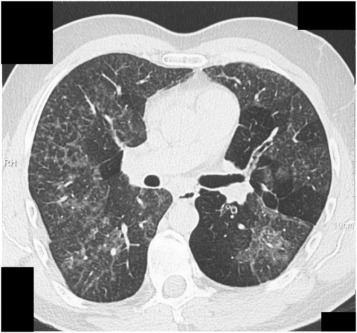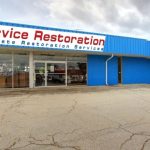
Household Mold and Hypersensitivity Pneumonitis: A Hidden Home Hazard
In today’s rapidly shifting home improvement landscape, it’s easy to overlook some of the more subtle dangers lurking in our living spaces. One such hazard is the mushrooming presence of household mold—which, far from being just an aesthetic nuisance, can have serious implications on respiratory health. Recent research has shed new light on how prolonged exposure to mold due to water damage inside the home can be linked to hypersensitivity pneumonitis (HP), an inflammatory lung disease. As someone deeply interested in home repair and maintenance, I feel compelled to share insights that combine medical findings with practical advice for homeowners.
In this opinion editorial, we’ll take a closer look at the hidden risks mold poses to lung health, examine the study findings from UT Southwestern Medical Center, and explore what homeowners can practically do to reduce these risks while preserving the integrity of their living spaces. With extreme weather events on the rise and water damage becoming more frequent, everyone from DIY enthusiasts to property managers needs to be aware of these intertwined issues.
Mold Growth at Home: Understanding the Tricky Parts of Indoor Air Quality
Household mold is more than just an unsightly blotch on your wall—it can be a silent contributor to respiratory diseases. When your home experiences chronic water damage, whether from a leaky roof or faulty plumbing, the resulting moist environment lays the groundwork for mold proliferation. These mold spores, when inhaled over time, may trigger an immune response that can lead to conditions like hypersensitivity pneumonitis.
HP, an inflammatory lung disease, arises when repeated exposure to molds or other allergens causes the immune system to attack the lung tissue. Because the symptoms of HP—such as a chronic cough and shortness of breath—are alarmingly similar to other respiratory conditions, correctly pinpointing household mold as the culprit becomes a confusing bit in the diagnostic process. Recognizing these connections can be the key to early intervention and improved health outcomes.
What is Hypersensitivity Pneumonitis and Why Should Homeowners Care?
Hypersensitivity pneumonitis (HP) is an inflammatory condition of the lungs that develops in some people after they repeatedly inhale certain antigens, including mold spores. In many cases, symptoms like chronic cough, shortness of breath, and fatigue mimic other respiratory conditions. For homeowners, understanding the origins of these symptoms is paramount because the usual culprits—such as outdoor pollutants—might be the last place you’d expect to find the source.
The challenge lies in the tricky parts of identifying the cause. Since HP can imitate other lung issues, healthcare professionals must rely on detailed environmental histories and less invasive tests, like bronchoscopy, to catch it early. In fact, one promising approach is focusing on the home environment—a space that offers both comfort and hidden dangers.
Making your way through the tangled issues of indoor mold requires keen observation and, quite often, the assistance of professionals such as industrial hygienists who specialize in detecting moisture and mold growth. A thorough inspection could be the difference between mitigating a small problem and avoiding a nerve-racking health crisis down the road.
Insights from the UT Southwestern Study: A Deeper Dive into the Data
A recent retrospective study led by UT Southwestern Medical Center has been pivotal in linking household mold exposure to the development of HP. The study reviewed records of 231 patients diagnosed with HP over nearly a decade. Out of these, 54 patients had developed HP directly from mold exposure within their homes. The research underlined that chronic or recurring water damage—which in many cases generated mold in spaces like bathrooms, bedrooms, and air conditioning units—served as the primary source of the problem.
What is particularly noteworthy about this study is its emphasis on the improvement seen in some patients after remediation measures were taken. Approximately 12% of patients, who took corrective actions like professional mold remediation or even moving out of their homes, saw significant improvements in lung function within a span of three to four months. These improvements were maintained long-term, even in fibrotic cases where recovery is typically more challenging. The study emphasizes the need for homeowners and clinicians to work together when it comes to environmental histories—making it clear that the subtle details of your environment can have super important health implications.
Here is a simplified table summarizing some of the key outcomes of the study:
| Study Aspect | Observation |
|---|---|
| Population Studied | 231 patients with HP, 54 with home mold exposure |
| Primary Mold Sources | Bathrooms, bedrooms, air conditioning units affected by chronic water damage |
| Impact of Remediation | ~12% experienced notable lung function improvements in 3-4 months |
| Median Survival (non-transplant) | Approximately 97 months |
This study not only highlights the connection between indoor mold and HP but also reinforces how essential it is for individuals to obtain a detailed inspection when facing unexplained respiratory symptoms. It reinforces the subtle differences between various lung conditions, showing the significance of catching the problem at the hidden stage before it escalates into something more severe.
Impact of Extreme Weather Events on Home Mold and Health Risks
In recent years, extreme weather events—ranging from heavy rains and flooding to storms—have increasingly threatened the structural integrity of homes across many regions, including North Texas. These weather patterns create the perfect setting for mold to thrive. With higher humidity levels and water intrusion becoming more common, even well-maintained homes can experience unexpected bouts of moisture buildup that lead to mold growth.
For homeowners, this intersection of climate and indoor maintenance introduces a set of tangled issues. It becomes ever more important to understand that even minor water damage can be the first domino in a series of complications: water damage leads to mold, and mold, as we discussed, can trigger HP in susceptible individuals.
Key steps for homeowners include:
- Regular inspection of roof, plumbing, and windows to anticipate leaks before they turn into chronic water problems.
- Prompt repair of any leaks or water damage to limit the creation of damp, mold-friendly environments.
- Utilizing dehumidifiers during periods of high humidity, particularly in rooms that are prone to moisture buildup such as basements and bathrooms.
By actively working through these measures, homeowners can better safeguard their indoor air quality and reduce the risk of mold-related health issues. It’s not just about having a neat, well-decorated space—it’s about protecting the health of everyone living in that space.
Preventative Home Maintenance: Tackling the Confusing Bits of Mold Remediation
Keeping your home mold-free is often more about managing your way through routine maintenance and remediation than it is about undertaking large-scale renovations. Mold remediation might sound overwhelming, but breaking the process down into manageable steps can simplify the task. Whether you’re a homeowner doing a DIY project or hiring professionals, knowing what to watch out for is crucial.
Start by doing the following:
- Inspect and Repair: Regularly check areas prone to moisture such as basements, attics, bathrooms, and kitchens. Look for any water stains, condensation, or visible mold growth. Early detection is key.
- Professional Assessments: Engage an industrial hygienist or mold remediation specialist. These experts can spot the subtle parts of mold growth that you might miss during your inspection.
- Proper Ventilation: Improve airflow by ensuring that your home’s ventilation system is clean and functioning effectively. This is especially important in areas where moisture tends to accumulate.
- Moisture Control: Use dehumidifiers and ensure proper insulation to prevent condensation on windows and pipes.
The precautionary steps might seem like a set of complicated pieces when viewed all at once, but tackling them individually can help you figure a path to a healthier, mold-reduced home environment. It’s about working through the twist and turns methodically rather than succumbing to the intimidating scale of the problem.
Key Home Maintenance Strategies to Mitigate Mold Exposure
Repairs and periodic updates are central to both effective home improvement and health security. Beyond immediate repairs for leaks or water damage, consider a long-term strategy that integrates routine maintenance with modern air quality solutions. Here are a few strategies to consider:
Implementing a Routine Home Inspection Schedule
Regular inspections can catch early signs of damage before they develop into full-blown issues. A yearly inspection by a qualified professional can help identify:
- Hidden leak sources in plumbing and roofing
- Ventilation issues that lead to trapped humidity
- Small mold patches that could expand if left untreated
By making these inspections a part of your home maintenance routine, you can avoid the nerve-racking scenario of discovering widespread mold only after symptoms arise in the family.
Incorporating Moisture Barriers and Modern Materials
Modern construction techniques and materials have come a long way in preventing water intrusion. Homeowners can opt for moisture-resistant building materials, such as:
- Waterproof insulation panels
- Moisture barrier paints
- High-quality seals for windows and doors
These solutions not only protect the aesthetic appeal of your home but also serve as part of a super important strategy to reduce long-term respiratory health risks associated with indoor mold exposure.
Professional Mold Remediation: When to Call in the Experts
Sometimes, the best course of action is to enlist professionals. While DIY projects are satisfying, the removal of persistent or widespread mold often requires the expertise of trained technicians. Consider professional mold remediation if you notice:
- Large or rapidly spreading mold patches
- Persistent damp areas despite your efforts at ventilation and dehumidification
- Unexplained health issues that may be linked to poor indoor air quality
While the process might seem intimidating, professional remediation can potentially prevent the nerve-racking progression of mold from a minor inconvenience to a serious health threat.
Integrating Home Improvements with Health Considerations
When making decisions about home remodels or improvements, it’s essential to consider not just the physical state of your property but also your health. With studies like the one from UT Southwestern highlighting the fine points of HP linked to mold, the connection between regular home maintenance and respiratory health becomes clearer.”
This interplay between construction improvements and improving indoor air quality provides dual benefits:
- Enhanced home value and aesthetic appeal
- Long-term health benefits by reducing exposure to airborne allergens
When you are looking to upgrade your living space, consider integrating healthy building practices. From enhanced insulation to smart HVAC systems that include air purification, the potential to create a home that is both functional and health-conscious is vast. As repairs and upgrades are undertaken, don’t forget to ask your contractor about moisture-resistant products and proper ventilation techniques.
Home remodel projects can sometimes feel full of problems, especially when you’re trying to steer through the subtle details of ensuring a healthier indoor environment. However, by planning thoughtfully, you not only enhance your living space aesthetically but also create an environment that actively supports wellbeing. Home improvement, in this sense, is truly a twofold investment—both in your property’s future and in your own health.
Proactive Steps for Homeowners: Managing Your Indoor Environment Effectively
For homeowners, the path to a mold-free and health-protective environment may appear loaded with issues. Yet, by taking proactive measures, you can reduce the risk of HP and other mold-related problems. Here are some practical action items that can guide you:
- Maintain a Clean and Dry Home: Regular cleaning routines, especially in high-moisture areas, help prevent mold spores from gaining a foothold. Use mold-killing cleaning solutions and ensure that bathrooms and kitchens are well ventilated.
- Monitor Humidity Levels: Invest in a hygrometer to keep track of indoor humidity. Aim for a level around 30-50% to minimize conditions conducive to mold growth.
- Respond Promptly to Water Intrusion: Whether it’s a small leak or noticeable water damage, addressing the source immediately can stop a trickle of water from turning into a larger mold outbreak.
- Schedule Regular Professional Inspections: At least once a year, have your home inspected by a professional who can detect the hidden complexities of dampness and mold growth that might not be visible to the untrained eye.
While these steps may seem like just another set of minor chores, they are super important in keeping your living space safe, healthy, and comfortable. By managing your indoor environment diligently, you significantly reduce the likelihood of encountering those tricky parts linked to serious respiratory conditions.
Bridging the Gap Between Home Improvement and Public Health
The convergence of home improvement practices and public health is becoming increasingly significant. The risks associated with household mold remind us that home projects aren’t just about aesthetics or increasing property value—they play a vital role in the health and safety of those who reside within.
Health experts and home maintenance professionals are now frequently collaborating to design guidelines that target both efficient home repairs and long-term wellness. Some of the collaborative efforts include:
- Enhanced Building Codes: Many regions are updating their building codes to require better moisture controls and improved ventilation systems.
- Public Health Campaigns: Local governments and health organizations are increasingly working together to educate communities on the signs of water damage and the benefits of regular home maintenance.
- Integrated Remediation Services: Companies are beginning to offer combined services that not only address structural repairs but also provide comprehensive mold assessments and remediation solutions.
By recognizing the full spectrum of home improvement—from the structural repairs and upgrades down to the small distinctions between different types of mold and their health impacts—we can foster a more integrated approach. This path moves us away from viewing home repairs solely as a matter of property upkeep and towards understanding them as an essential component of our overall quality of life.
Taking the Wheel: A Call to Action for Homeowners
As a homeowner, the thought of managing all these twist and turns—from small leaks to potential health risks—can seem overwhelming. Yet, being proactive is the best way to steer through these complicated pieces. The UT Southwestern study has opened our eyes to the often-overlooked connection between something as commonplace as household mold and a complex health condition like hypersensitivity pneumonitis.
Here’s a recap of the essential steps you can take:
- Regularly inspect your home for signs of moisture and mold, making note of any recurring water damage.
- Don’t wait until symptoms such as chronic cough or shortness of breath appear—seek professional help for environmental assessments early.
- Invest in proper ventilation, modern building materials, and moisture control equipment to combat mold growth at the source.
- Stay informed on local weather patterns and potential water intrusion issues. Adapting your home maintenance strategy according to seasonal changes can make a significant difference.
These actions are not merely about preserving your property’s aesthetics; they are about protecting your health and ensuring that your home remains a safe haven. While it might at times feel as if you’re dealing with a full slate of issues, each small step counts as progress toward a healthier living environment.
Conclusion: Merging Home Improvement With Health Awareness
In conclusion, the emerging evidence connecting household mold to hypersensitivity pneumonitis serves as an important reminder that our homes have the power to impact our health in unexpected ways. As we continue to push forward with home improvement projects, it’s important to also pay attention to the environmental factors that might silently affect our wellbeing.
Homeowners should embrace routine maintenance, regular inspections, and modern preventive measures as key components of both a beautiful home and a healthy life. Integrating these practices into our daily routines not only prevents the small distinctions from turning into major health hazards but also empowers us to take control of our living spaces.
By recognizing that the tiny details—from the subtle presence of mold in the bathroom to the overlooked leak behind a wall—can have immense consequences, we are better equipped to address the challenges of mold exposure. So, as you plan your next round of home improvements, remember that health and home go hand in hand.
Ultimately, ensuring a safe, mold-free home is a commitment that benefits everyone. Taking a proactive stance today can prevent potential health issues tomorrow. As the evidence unfolds and the weather continues to throw curveballs at our infrastructure, there’s never been a more crucial time to invest in both your home’s future and your own well-being.
The steps are clear, the risks are real, and the benefits of maintaining a healthy home environment extend far beyond mere aesthetics. It’s time to think of home improvement as a holistic endeavor—one where every repair, every inspection, and every upgrade is a step toward not only enhancing your property’s value but also securing a healthier outcome for you and your family.
Let this serve as a call to action for all homeowners: be vigilant, be proactive, and be passionate about creating a living space that is as safe as it is beautiful. Your home is more than just a structure; it’s the place where memories are made and health is nurtured. Consider each improvement a vital investment in the quality of life you deserve.
Originally Post From https://respiratory-therapy.com/disorders-diseases/chronic-pulmonary-disorders/chronic-diseases/household-mold-linked-to-hypersensitivity-pneumonitis/
Read more about this topic at
Black Mold Exposure: Symptoms, Risks & Treatment
Mold in the home and how it can affect health


